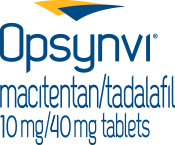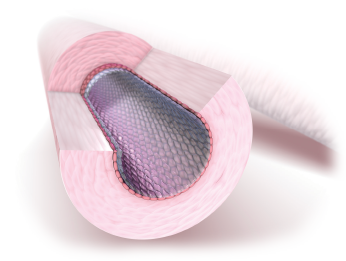
This site is intended for
U.S. healthcare professionals
PAH Is a Rare, Serious, and Progressive Disease1
- PAH results from restricted flow through the pulmonary arteries, leading to increased PVR2
- Increased pulmonary vascular resistance (PVR) leads to a decline in RV function and eventual RV failure2
Hemodynamic definitions of PH and PAH1
The definitions are based on hemodynamic assessment by an RHC
mPAP >20 mmHg
mPAP >20 mmHg
PAWP ≤15 mmHg
PVR >2 WU
PAH symptoms may present like other lung conditions3,4
- While a majority of patients present with dyspnea on exertion, it is important to distinguish PAH from other cardiac or pulmonary etiologies such as asthma or COPD
Common signs and symptoms of PAH in the REVEAL Registry3*†

- Percentages are
approximations.

Actor portrayal.
PAH is associated with diverse pathologic events
The pulmonary arteries contract, and vascular resistance increases.5,6
Chronic elevated pressures lead to right ventricular strain and overload.5,7
Over time, the vascular intima thickens, further impeding blood flow.7
Vascular hypertrophy occurs in the presence of developing lesions and other arterial abnormalities.7,8
Abnormalities in platelet activation and function promote thrombosis and can lead to increased vasoconstriction.8
There are 3 foundational pathways in PAH with specific drug classes1
- PAH involves an imbalance of 3 naturally occurring chemicals found in the body: endothelin, prostacyclin, and nitric oxide, which contribute to changes in the blood vessels1,7
PDE5is, sGCs promote
- Vasodilation
- Anti-proliferation
ERAs prevent
- Vasoconstruction
- Cellular proliferation

Prostacyclin pathway agents promote
- Vasodilation
- Anti-proliferation
- Anti-inflammation
- Anti-thrombosis
PVR is caused by narrowing of the pulmonary arteries2
Increased PVR leads to a decline in RV function and eventual RV failure.2
Hemodynamic changes correlate with increasing severity of PAH5


Normal PVR ≤2 Wood units.1
Elevated PVR >2 Wood units.1
Adapted from Eur Respir Rev. 2011;20(122):236-242.
2022 ESC/ERS Guidelines: Focusing on multiple pathways is an effective treatment strategy with clinical benefits1
Science Liaison (MSL)Contact your MSL
†
REVEAL is a US-based observational registry involving 55 academic- and community-based treatment centers. 3515 patients enrolled between March 2006 and December 2009.12,13
COPD=chronic obstructive pulmonary disease; ERA=endothelin receptor antagonist; ERS=European Respiratory Society; ESC=European Society of Cardiology; mPAP=mean pulmonary arterial pressure; PAH=pulmonary arterial hypertension; PAP=pulmonary arterial pressure; PAWP=pulmonary arterial wedge pressure; PDE5i=phosphodiesterase type 5 inhibitor; PH=pulmonary hypertension; PVR=pulmonary vascular resistance; REVEAL=Registry to Evaluate Early and Long-term PAH Disease Management; sGCs=soluble guanylate cyclase stimulator; WU=Wood units.
References: 1. Humbert M, Kovacs G, Hoeper MM, et al; ESC/ERS Scientific Document Group. 2022 ESC/ERS Guidelines for the diagnosis and treatment of pulmonary hypertension: the Task Force for the Diagnosis and Treatment of Pulmonary Hypertension of the European Society of Cardiology (ESC) and the European Respiratory Society (ERS). Eur Heart J. 2022;43(38):3618-3731. 2. Lai Y-C, Potoka KC, Champion HC, et al. Pulmonary arterial hypertension: the clinical syndrome. Circ Res. 2014;115(1):115-130. 3. Brown LM, Chen H, Halpern S, et al. Delay in recognition of pulmonary arterial hypertension: factors identified from the REVEAL Registry. Chest. 2011;140(1):19-26. doi:10.1378/chest.10-1166. 4. Bostwick D, Hatton ND, Mayeux JD, et al. The approach to the patients with chronic dyspnea of unclear etiology. Adv Pulm Hypertens. 2018;16(3):103-111. 5. Howard LS. Prognostic factors in pulmonary arterial hypertension: assessing the course of the disease. Eur Respir Rev. 2011;20(122):236-424. 6. Minai OA, Budev MM. Diagnostic strategies for suspected pulmonary arterial hypertension: a primer for the internist. Cleve Clin J Med. 2007;74:737-747. 7. McLaughlin WV, Archer SL, Badesch DB, et al. ACCF/AHA 2009 expert consensus document on pulmonary hypertension. J Am Coll Cardiol. 2009;53(17):1573-1619. 8. Blaise G, Langleben D, Hubert B. Pulmonary arterial hypertension: pathophysiology and anesthetic approach. Anesthesiology. 2003;99(6):1415-1432. 9. Gale S. The evolving treatment landscape of pulmonary arterial hypertension. Am J Manag Care. 2021;27(3 suppl):S42-S52. doi:10.37765/ajmc.2021.88610. 10. Yoo HHB, Marin FL. Treating inflammation associated with pulmonary hypertension: an overview of the literature. Int J Gen Med. 2022;15:1075-1083. doi: 10.2147/1JGM.S295463. 11. Lang MI, Gaine SP. Recent advances in targeting the prostacyclin pathway pulmonary arterial hypertension. Eur Respir Rev. 2015;24(138):630-641. 12. McGoon MD, Miller DP. REVEAL: a contemporary US pulmonary arterial hypertension registry. Eur Respir Rev. 2012;21(123):8-18. 13. Badesch DB, Raskob GE, Elliott CG, et al. Pulmonary arterial hypertension: baseline characteristics from the REVEAL Registry. Chest. 2010;137(2):376-387.
